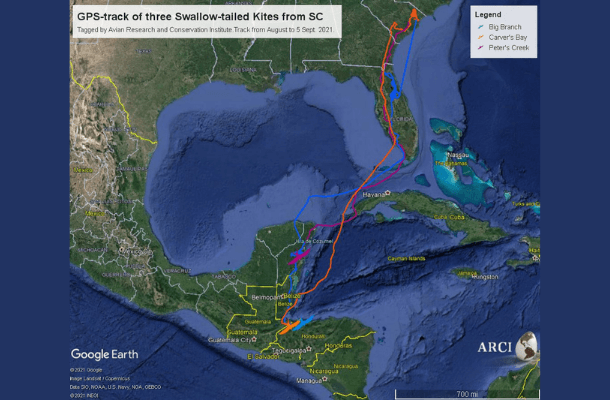Onlookers “Tag Along” with Southbound Swallow-tailed Kites

American Bird Conservancy (ABC) and partners are following the migratory journeys of three Swallow-tailed Kites to gather data that will help inform conservation measures across this bird's range, to help assure a brighter future for the kites and their southeastern forest habitats. Photo by David Spates
(September 17, 2021) The Swallow-tailed Kite is one of North America's most beautiful birds of prey, with distinctive black-and-white plumage, narrow wings spanning four feet, and a forked, elongated tail. Although the U.S. population of this migratory raptor is considered stable, it is much reduced from numbers of the past. American Bird Conservancy (ABC) and partners are following the migratory journeys of three Swallow-tailed Kites to gather data that will help inform conservation measures across this bird's range, to help assure a brighter future for the kites and their southeastern forest habitats.
ABC collaborated in June with International Paper and the Avian Research and Conservation Institute (ARCI) to successfully capture, tag, and release the three kites near Georgetown, South Carolina. Other partners included Resource Management Service, Forest Investment Associates, and White Oak Forest Management.
Each bird was fitted with a GPS transmitter that will track its movements throughout the year. Swallow-tailed Kites are long-distance migratory birds, spending their spring and summer months in the southeastern U.S. and wintering in Central and South America.
“Since early spring, these kites were roosting, feeding, and nesting within the same working forest landscape where International Paper and other forest companies produce and procure the wood fiber that goes into many of the products we use every day,” says Emily Jo Williams, ABC's Vice President for the Southeast Region.
“The data these birds provide will help us ensure that these sustainable working forest landscapes provide society with renewable forest products and critical habitat for Swallow-tailed Kites and a host of other wildlife species,” Williams says. ”We look forward to what the kites can tell us about their wintering grounds over the next few months, and to learn more when they return to the southeastern U.S. in spring 2022.”

A map of the tracked flight paths for three Swallow-tailed Kites that were successfully captured, tagged, and released through ABC's collaboration with International Paper, Avian Research and Conservation Institute, Resource Management Service, Forest Investment Associates, and White Oak Forest Management.
Over the past two months, the team has been “watching” the three tagged birds, each carrying the name of its nesting location along with its GPS transmitter. As of September 2, all three kites departed breeding areas in South Carolina, traveled through Florida, and successfully crossed the Gulf of Mexico.
According to ARCI, the timing and tracks across the Gulf for these Swallow-tailed Kites are shaped by the prevailing winds of hurricanes and tropical storms that were active in the Caribbean and Gulf of Mexico at the time. These birds apparently can sense related changes in the atmosphere and respond by using favorable tailwinds to cross the open water as fast as possible.
“Despite all the tropical storm activity in late August and early September,” says Williams, “we have witnessed ‘textbook' migration pathways used by our tagged Swallow-tailed Kites that have carried them across the Yucatán Channel and western Caribbean.”
The bird known as Carver's Bay left Florida on August 13, crossed the Gulf for an astounding 41 hours before landing in southern Belize, and last checked in from Honduras on September 5. Big Branch left Florida on August 17, stopped over in Mexico, and is currently also in Honduras. Peters Creek was the last to leave South Carolina on August 30, traveling over Naples and the southern tip of Florida, stopping for a night in western Cuba, and then crossing to the Yucatán Peninsula in Mexico, where he arrived on September 2 and remains for now. As the birds continue into South America, they will have to traverse the Andes Mountains to finish their journey to wintering areas in Brazil and Bolivia.
You can follow along and keep track of these Swallow-tailed Kites at ARCI's blog or on their Facebook page.
Read more about ABC's and partners' work with Swallow-tailed Kites here.
###
American Bird Conservancy is a nonprofit organization dedicated to conserving wild birds and their habitats throughout the Americas. With an emphasis on achieving results and working in partnership, we take on the greatest problems facing birds today, innovating and building on rapid advancements in science to halt extinctions, protect habitats, eliminate threats, and build capacity for bird conservation. Find us on abcbirds.org, Facebook, Instagram, and Twitter (@ABCbirds).
Media Contact: Jordan Rutter, Director of Public Relations| jerutter@abcbirds.org | @JERutter


















































